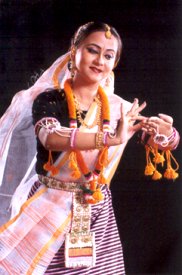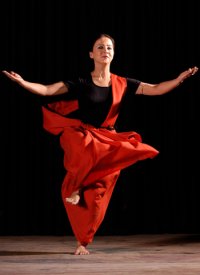
|
 |

|
 |
A tête-à-tête with Bimbavati Devi, Manipuri dance exponent - Febina Mathew, Fargo, North Dakota e-mail: febina@gmail.com October 13, 2004  Bimbavati danced like a Trojan...her movements bore the evidence of one born to the dance family - The Hindu, Leela Venkatraman, dance critic and scholar. The Manipuri Nartanalaya, a premier institute for dance in Kolkata, India, presents the renowned style of Kalavati Devi and late Guru Bipin Singh through the performances of their daughter Bimbavati Devi. She was initiated into the world of dance and music at a very tender age. Besides dancing, she has also undergone training in pung (Manipuri mridang) and recently initiated into Thang Ta (Manipuri martial art). Bimba, an empanelled artiste of Indian Council for Cultural Relations (ICCR), has performed in various prestigious dance programs and festivals in India and abroad. Awards galore have come her way, including Shringar Mani conferred by Sur Singar Samsad (Mumbai), Nandita Kripalini Award from West Bengal State Academy of Dance, Drama, Music, and Visual Arts, and recently, the Samskriti Award (2004). She is also the recipient of Junior and Senior National Scholarship in Manipuri Dance from the Department of Culture, India.  Was the advance to Manipuri dance a natural step? My parents Guru Bipin Singh and Kalavati Devi are Manipuri dance exponents and you can well imagine what the atmosphere of our house would be like. I don't really remember when I started dancing and when my formal training in dance began. It came very naturally to me. I remember my mother asking our percussionist to play the pung (the traditional Manipuri drum) properly so I can concentrate on my studies. How is Manipuri dance different from other Indian dance styles? All Indian dance styles are beautiful and they have their special characteristics. Manipuri is very free flowing and the movements are lyrical like waves. One of the unique features of this dance form is that the lasya and tandava aspects are different from each other. Even the costumes are different. Lasya is soft and has subtle movements, while tandava is vigorous. The torso movement of our dance form is yet another unique feature. It is however not similar to the torso movement of Mohiniattam or Odissi. Many artists have stepped into the realm of contemporary dance through exploration of one or many dance styles or martial arts such as Kalaraipayattu of Kerala and Chhau of eastern India etc. Are you into contemporary work? I have just started experimenting with Manipuri dance and Thang Ta. My very recent production was Anubhavaamah which is based on the Shara Ripu or the 6 cardinal vices (kama, krodha, lobha, moha, mada and matsarya) of men. Have well have you trained in Thang Ta and how have you tried to incorporate this into Manipuri dance? I have only recently started my training. Instead of the actual fighting techniques, I am more interested in its movements, which are graceful but very bold at the same time. When we do traditional dance items, we don't really use the movements of Thang ta - only in choreographic works. Your major performances include Khajuraho Festival, Konark Festival, Uday Shankar Festival, Nishagandhi Festival, Soorya Festival etc. Were these presentations pure Manipuri or contemporary works? Both. What was the response of the audience, both in India and abroad to these performances? Till date they have liked it. Anubhavaamah was widely acclaimed by the press and public. In a year it was staged 7 times. You are one of the upcoming Manipuri dancers and choreographers today. Are you satisfied with the stand of Manipuri dance in India and abroad today and what changes do you foresee in the future in Manipuri dance? The popular notion is 'Manipuri dance is very monotonous, slow, the movements are repetitive...there isn't much variation, it can only be used to compose Tagore's songs...they only wear the big round costume and move like a doll etc etc'. It's really painful when we hear these things. For the past 30 years, our institution Manipuri Nartanalaya has been making sincere efforts to break this notion. We have tried to infuse verve and color into the dance form by being inspired by several aspects of Manipuri dance, for example- the movements of pung cholom and kartal cholom. Their movements are very stylized and dignified. We want to make people aware of the richness of Manipuri dance. Maybe that is one reason why our gharana is quite different form the other gharanas. I am definitely not saying that other gharanas are not up to the mark. Our styles are different. I want people to know that Manipuri dance is not just a dance wearing the big round costume...we wear that only in traditional ras leelas. But ras leelas are popular because they are so lively and the dress is so colorful and bright. We are trying to propagate and perpetuate this dance form far and wide. You are currently performing in US. Can you brief me on the dance production for this tour? In US, I have been invited to perform at the Festival of India organized by the Asian Dance and Music Program of the University of Massachusetts. I will do only traditional Manipuri dance items here. I will be accompanied by Sucharita Sharma and Jagannath Singh in 2 or 3 items. Besides this, I have lecture demonstrations and workshops at several places. I presented a small choreographic work of mine named Dhriti in a show organized by Kala Anjali India Culture Center and ASI, North Dakota State University in Fargo, ND. What is your most cherished achievement? The day is yet to come. My most cherished achievement would be when Manipuri dance will be in a much better position than today. I definitely cannot do this alone. All the Manipuri dancers have to realize this and make a sincere effort. Advice to budding artists and dance enthusiasts? I am also an upcoming artiste. One thing I can say is that if you try to learn many dance forms then you will not be able to do justice to any of them. Concentrate on one and try to go deep into it. The responsibility to keep our country's heritage and tradition alive lies in our hands. Contact: Bimbavati Devi, 15A, Bipin Pal Road Near Deshapriya Park Kolkata 700026, India Ph: (91-33) - 24641922 Mobile: 98300-29586 Fax: (91-33) - 24643267 Email: bimbavati@yahoo.com Febina Mathew is a Bharatanatyam dancer and writer based in Fargo, North Dakota. She is also a volunteer for RASIKA. |